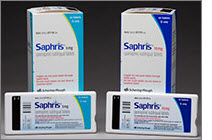 On August 14, 2009, the FDA approved Saphris (asenapine) as a new second-generation antipsychotic for the treatment of both schizophrenia and bipolar disorder. It is available only as a sublingual tablet, meaning that it is not effective if swallowed, and it must be left under the tongue to dissolve for it to be absorbed into the bloodstream. The available studies haven’t shown that Saphris (asenapine) provides any unique therapeutic advantage over other second-generation antipsychotics. The main contribution is that clinicians and patients will have yet another option, as if the clinical community needs another antipsychotic that is not special in any other way, and certainly not deserving of “novel” or “designer” drug status.
On August 14, 2009, the FDA approved Saphris (asenapine) as a new second-generation antipsychotic for the treatment of both schizophrenia and bipolar disorder. It is available only as a sublingual tablet, meaning that it is not effective if swallowed, and it must be left under the tongue to dissolve for it to be absorbed into the bloodstream. The available studies haven’t shown that Saphris (asenapine) provides any unique therapeutic advantage over other second-generation antipsychotics. The main contribution is that clinicians and patients will have yet another option, as if the clinical community needs another antipsychotic that is not special in any other way, and certainly not deserving of “novel” or “designer” drug status.
The manufacturer, Schering-Plough, is promoting the drug on the premise that it’s more effective at improving the negative and cognitive symptoms of schizophrenia compared to other atypical antipsychotics, and that Saphris (asenapine) has a better safety profile.
The safety profile issue has been used over and over before. While the drug demonstrated less weight gain compared to Risperdal ( risperidone) or Zyprexa (olanzapine), it has an elevated level (18%) of extrapyramidal symptoms (EPS) – comparable to first generation antipsychotics.
Schering-Plough’s specialty sales force is handling the detailing of Saphris (asenapine) – as opposed to its primary cast of sales representatives – targeting psychiatrists to prescribe this new antipsychotic.





Leave A Comment
You must be logged in to post a comment.